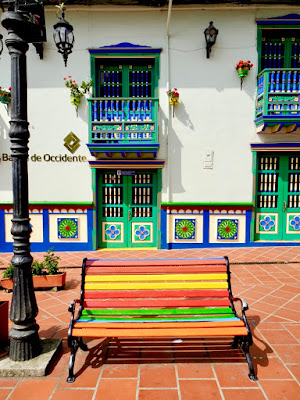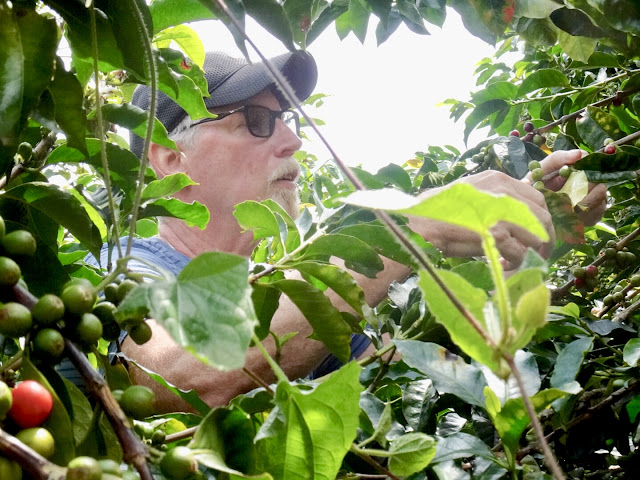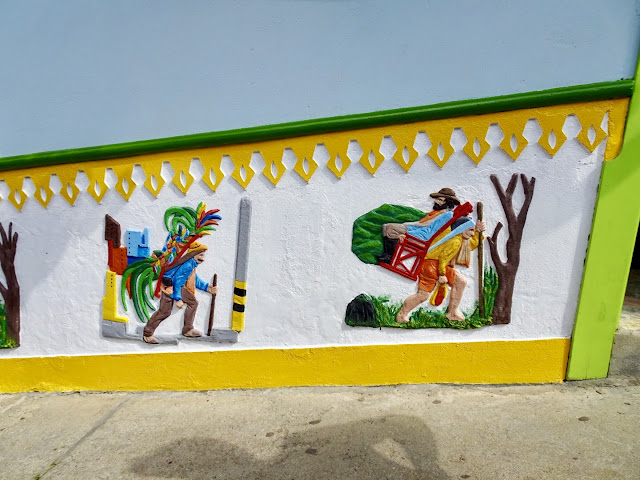We spent Day 3 touring around with Ana from:
medellindaytrips
She picked us up in a very comfortable vehicle promptly at 8am. She gave us some history on Medellin while we drove. For only 22 years old, she knows a LOT about Medellin. We recommend her to anyone looking for a tour guide.
Our first stop was to taste some fruit that we’ve never heard of before.
 |
| Ana collecting our fruit samples. |
 |
| We tried Pitaya (it's yellow but looks just like dragon fruit inside) Granadilla (the orange ones on the right, very light almost styrofoam shell, slimy and sweet on the inside) Maracuya (The smaller yellow one at the top and middle. Same as Granadilla but more sour) Gulupa (the smaller purple one, like granadilla but even sweeter) Guava (the green one, eaten like an apple. It's pink with little seeds on the inside.) Not pictured is Lulo and we tried another fruit that looked to me like a Prickly Pear that grows on cactus. It was nice to get to taste some of the fruits that look so foreign to us in the stores and on the street. Pitaya was my favourite and I often bought it from our local Exito. |
 |
| John and Brenda slurping their sweet Granadilla. |
 |
| After fruit tasting, we learned all about the man made reservoir created by electric company EPM. The city of El Penol used to be here but was relocated. In the distance they have a cross sticking out of the water where the church used to be. |
 |
| EPM built the people of El Penol this replica town square as a tribute to Old Penol. |
 |
| Mike and John in typical Colombian gear. |
 |
| Every town square is complete when there is a statue of Simon Bolivar |
 |
| After our tour of El Penol we headed to this beautiful little family owned organic coffee plantation. Cafe Oriente Excelso. The view they have while picking coffee is stunning. |
 |
| The coffee bushes on the steep mountain side. The tall ones in the back are actually orange trees. |
Learning the different stages of the coffee bush from seed to bush to bean
 |
| First they grow a white flower and then green beans grow - don't pick these ones! |
 |
| These red beans are ready to pick! |
 |
| Let's do this! |
The beans on this plantation are picked by hand. There are so many bushes all at different stages, that they have to pick daily for hours to keep up.
 |
| Brenda putting her excellent gardening skills to work. |
 |
| They wear a bucket around their waist so both hands are free for picking. |
 |
| So many beans ready to be picked. |
 |
| Once picked, this machine removes the outer red shell. It's mostly automatic but there are a lot of beans that need to be sorted out. |
 |
| The orange trees effect the flavour of the beans. This is a good thing, making their coffee unique. |
 |
| Next step, the beans are dried and sorted. |
You can see the difference between a dried "good" bean and a "bad" one. A good bean is a beautiful light beige colour with no brown spots. They are sorted by hand because only the very best beans are exported. The "bad" ones aren't really that bad, they just aren't perfect enough be exported ... they stay in Colombia and are sold to local companies. This explains why we were so choosy about our coffee while in Colombia. Most of it is the "bad" stuff. We did eventually find good coffee in Colombia - but there was a considerable price difference. Lucky for us, we were able to purchase fresh roasted beans direct from the farm at an amazing price. They keep a specific amount of their crop for resale in a few places in Colombia and direct from their little shop on the farm. The rest of it is shipped out of the Country.
 |
| The farm co-owner and her grandson. |
 |
| He was sharing his beans with us. Such a cutie! |
 |
| If they are roasting their own beans, this machine takes off the white shell to expose the bean inside. If the beans are to be shipped, they are shipped in their white shell to maintain maximum freshness. |
This is the roaster. The beans that they keep are roasted for approximately 15 minutes to obtain the exact flavour they want.
 |
| Bean from dried, shelled, roasted and finally ground. |
Once the beans were ground, it was time for a tasting! This coffee pairs beautifully with anything fruity or with chocolate. We purchased some coffee for our apartment and for home as well as some chocolate that I ate in the car before we got to our next destination.
Have a look at our next destination!! Isn't that huge rock super interesting? How has it resisted erosion all these years?
 |
| La Piedra Del Penol - The Big Guatape Rock |
 |
| The rock is 656 feet (200 meters) tall. |
 |
| 650 steps to the top and 740 to the lookout. |
 |
| Half way up you can say a little prayer to the Virgin Mary. |
 |
| We made it to the very top! From this viewpoint you can see how large the man made Guatape - Penol reservoir really is. |
 |
| Staircase down is a little narrower. |
We did it! Total time up and back down was 40 minutes. My legs were trembling a little. I don't recommend climbing all those stairs in flip flops.
The gorgeous view was worth every step.
 |
Our last destination for the day was Guatape. The most colourful little town in all of Colombia.
It’s known for its houses decorated with colourful bas-reliefs. Each one tells a story in its own way. |



 |
| This is Memory Lane. |
 |
| Our tour finished with lunch. Mike and I split the order. This is my half. I love how they cut everything exactly in half. This is a typical Colombian dish called Bandeja Paisa. Missing from the photo is my half bowl of bean soup. |
Next up on the blog .... our day trip to Playa Blanca ....
Adios!






































































No comments:
Post a Comment